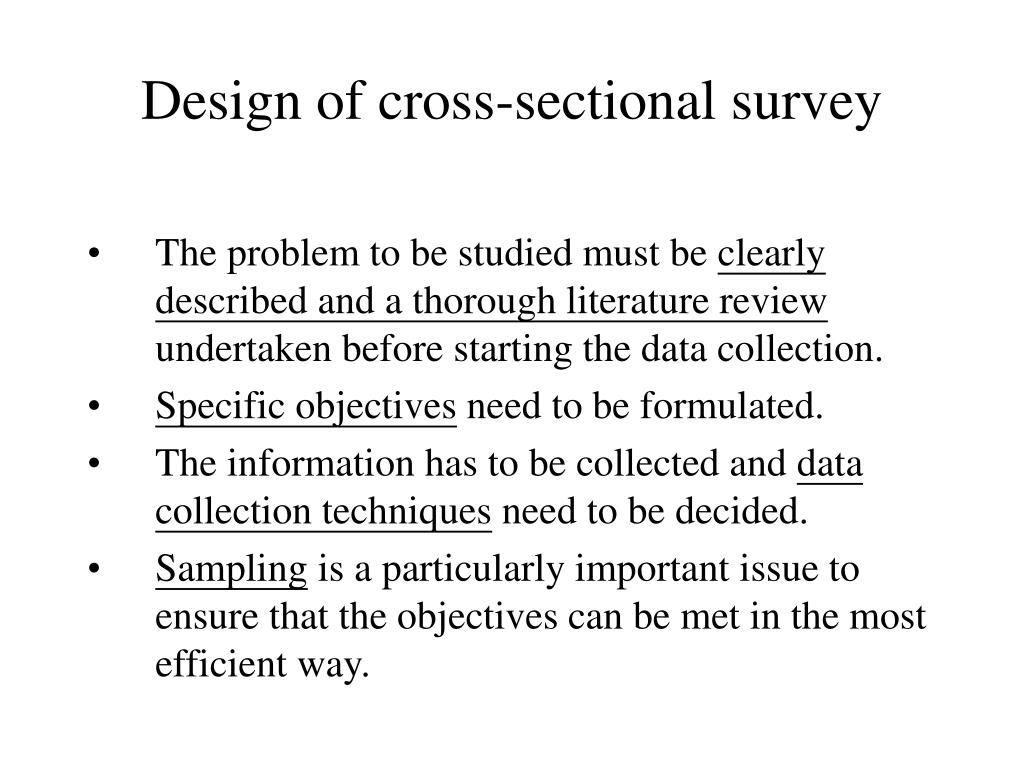Table Of Content

Cross-sectional studies can be categorized based on the nature of the data collection and the type of data being sought. For example, a cross-sectional study could be used to investigate whether exposure to certain factors, such as overeating, might correlate to particular outcomes, such as obesity. In this study, researchers examine a group of participants and depict what already exists in the population without manipulating any variables or interfering with the environment.
Cross-sectional study examples

All people have at least one variable in common – being related – and multiple variables they do not share. Hence, this research type “takes the pulse” of population data at any given time. Longitudinal studies tend to require more resources; these are often more expensive than those used by cross-sectional studies.
Multiple variables and outcomes can be researched and compared at once
Also, you can find advanced data analysis tools such as trend analysis and dashboards to visualize your information and do your own cross-sectional studies simply and efficiently. Research by a phone manufacturer throughout the target demographic market validates the expected adoption rate and potential phone sales. In cross-sectional studies, researchers enroll men and women across regions and age ranges for research. Although they are both quantitative research methods, there are a few differences when comparing and contrasting cross-sectional and longitudinal studies.
Create and Analyse a Cross-Sectional Study Survey
While such studies cannot establish a causal link and do not quantify a variable, they can highlight a relationship that might be worth further investigation. One of the advantages of a cross-sectional study is that it plays a key role in developing hypotheses and in laying the foundation for a more comprehensive research project. It’s cost-effective, quick to conduct, and provides a broad view of a population’s characteristics or behaviors at a specific time. Another example of a cross-sectional study would be a medical study examining the prevalence of cancer amongst a defined population.
Data collection and ethical considerations
It can be used to assess the prevalence of outcomes and exposures, determine relationships among variables, and generate hypotheses about causal connections between factors to be explored in experimental designs. This study revealed a high demand for smoke-free housing among MUH residents in urban Bangladesh. Most of the residents favoured a smoke-free building policy for MUH which imposes smoking bans inside entire buildings and also within a distance of 25 feet from entrances. Those who stayed at home for a longer time, were non-smokers, and had smoking family members were more likely to choose this policy. However, further research involving diverse stakeholders is needed to generate stronger evidence on policy choice for smoke-free MUH. It was found in the present study that MUH residents who spent more than 12 hours a day within a housing complex were more likely to choose a smoke-free building policy than those who spent 12 hours or less a day within a housing complex.
Statistical analysis
Association between sarcopenia and osteoarthritis among the US adults: a cross-sectional study Scientific Reports - Nature.com
Association between sarcopenia and osteoarthritis among the US adults: a cross-sectional study Scientific Reports.
Posted: Tue, 02 Jan 2024 08:00:00 GMT [source]
Cross-sectional studies look at a population at a single point in time, like taking a slice or cross-section of a group, and variables are recorded for each participant. QuestionPro provides various tools for analyzing your collected data, cross-tabulation, and more. Whether you’re a researcher, marketer, or business professional, QuestionPro can help you gather the data you need to make informed decisions. Check out some of the critical advantages of conducting online research using cross-sectional studies and see if it’s a good fit for your needs.
What are the limitations of cross-sectional studies?
With an inappropriate response rate of approximately 10%, 152 participants were selected for the study. A total of 152 people responded, and 143 were selected for the final analysis after excluding nine people who gave biased responses. The NLN/Jeffries theory of simulation [14] explains that within the overall context of simulation-based education, simulation design influences the simulation experience, resulting in simulation-based education outcomes.
Association between perceived neighborhood environment and depression among residents living in mega ... - BMC Public Health
Association between perceived neighborhood environment and depression among residents living in mega ....
Posted: Thu, 01 Feb 2024 08:00:00 GMT [source]
Measurement of covariates characteristics
Flat owners and tenants together make up the resident population of a private MUH complex. On the contrary, government MUH complexes, popularly known as the government residential quarters in Bangladesh, accommodate government employees on a rent basis. Adults aged 18 or older who had been living in MUH for at least 2 years were eligible to participate in the study. We excluded pregnant women and people with speech and/or hearing impairments from this study to avoid communication barriers.
Cross-sectional vs. longitudinal studies
Participants with the rare condition of interest might not be identified in the study sample. The statistical literature has numerous articles discussing the pros and cons of using either the POR/OR or PR/RR for cross-sectional studies (Tamhane et al., 2016). Consulting a statistician to discuss the best choice for each project is highly recommended. However, according to Alexander and colleagues (2015a), the POR is preferred when the study topic is a chronic condition (i.e., hypertension, HIV), or the risk of developing the disease takes several months to develop. For studies evaluating acute conditions (i.e., the common cold), the PR is favored (Alexander, 2015a). Cross-sectional studies are not designed to follow individuals forward in time (prospective) or look back at historical data (retrospective), as they analyze data from a specific point in time.

Please choose from one of our 350+ survey templates, or build your own and leverage our reporting tools to discover deep insights to apply to your best work. We’ll review examples and explain the types of cross-sectional studies you might perform. We’ll also take a closer look at the benefits of this valuable research for the work you do.
Since cross-sectional studies are suitable for examining chronic diseases or conditions, the POR is generally the ideal measure of association to use (Alexander, 2015a). Because all of the variables are analyzed at once, and data does not need to be collected multiple times, there will likely be fewer mistakes as a higher level of control is obtained. This design measures the prevalence of an outcome of interest in a defined population. It provides a snapshot of the characteristics of the population at a single point in time. The infrastructure development of Mymensingh City was still in its embryonic stage when we designed the study; therefore, we did not include this city in the study.
This chapter addresses the peculiarities, characteristics, and major fallacies of cross-sectional research designs. A cross-sectional study aims at describing generalized relationships between distinct elements and conditions. The specific case and its particularities are not the focus, but all instances and cases. So cross-sectional studies try to establish general models that link a combination of elements with other elements under certain conditions. Also, researchers find relevant information on how to write a cross-sectional research design paper and learn about typical methodologies used for this research design. The cross-sectional study design is the most commonly used design and generally has an analytical component to test the association between the risk factor and the disease.
In recent years, many studies on simulation education in Korea have identified learning outcomes and defining factors after training [5,6,7, 9, 12, 20]. However, there is a lack of research on the role of flow in learning design and simulation educational satisfaction. The significance of the current study lies in its confirmation of the link between simulation design and simulation educational satisfaction, as well as the mediating function of flow. Nursing students can achieve simulation educational satisfaction through simulation-based education if simulation educators follow best practices that improve flow through well-organized simulation design. A total of 2,811 nurses were enlisted at Shengjing Hospital in China during the period from March to April, 2022.
The researcher can evaluate people of different ages, ethnicities, geographical locations, and social backgrounds. For example, a university might post a short online survey about library usage habits among biology majors, and the responses would be recorded in a database automatically for later analysis. This is a simple, inexpensive way to encourage participation and gather data across a wide swath of individuals who fit certain criteria. Cross-sectional studies typically allow researchers to collect a great deal of information quickly. Researchers are then able to amass large amounts of information from a large pool of participants. In economics, cross-sectional studies typically involve the use of cross-sectional regression, in order to sort out the existence and magnitude of causal effects of one independent variable upon a dependent variable of interest at a given point in time.


No comments:
Post a Comment